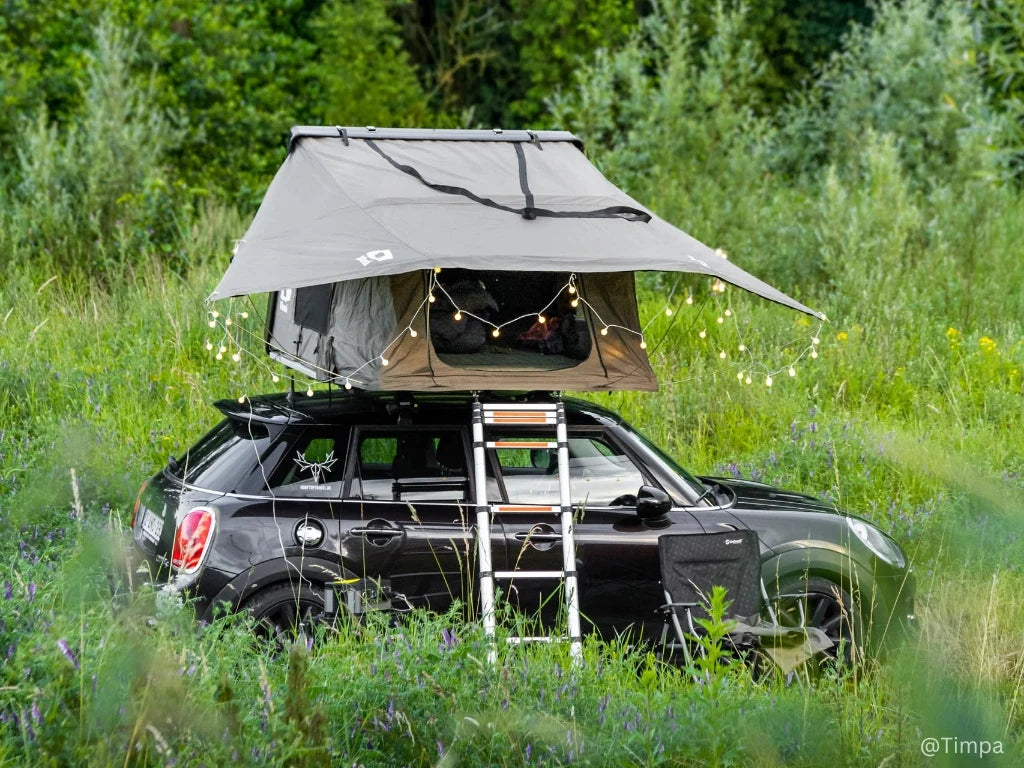When the weather turns damp, you might be wondering whether your roof tent can handle the rainy conditions. You can absolutely use a roof tent in the rain; many roof tents are designed with wet weather in mind, but you need to make sure you have the right features that enable them to withstand rain.
In this article we discuss what features of a roof tent make them able to withstand the rain, how waterproof roof tents are, and additional tips for camping in the rain.

Manufacturers often equip roof tents with a sturdy rain fly and waterproof coatings, alongside additional accessories like a canopy, to shelter the entrance and ladder area.
Key Takeaways
- Roof tents are built with tent canvas material that has very good levels of waterproofing.
- Make sure your rain fly is correctly assembled to reduce rain entering your roof tent.
- Regular maintenance and diligent setup enhance protection from rain.
- An Awning or an annex room can provide you additional cover from the rainy weather
Essentials of Rooftop Tents in Rainy Conditions

When camping in the rain, using a roof tent can provide a dry, comfortable, and safe experience away from wet ground. Below you'll find specifics on selecting and using a rooftop tent in wet weather.
Assessing Weather Conditions
Before setting out, check the forecast for heavy rain and plan accordingly. Your rooftop tent should be able to withstand the conditions you expect to face.
Benefits of a Rooftop Tent Over a Ground Tent in the Rain
A rooftop tent keeps you elevated off the ground versus regular tents, reducing the risk of water ingress. This elevation ensures a more comfortable sleep and protection from water pooling beneath you, which is a common issue with traditional tents during rainfall.
Selecting the Right Roof Tent Material
For camping in the rain, ensure your rooftop tent is made of high-quality waterproof materials like poly-cotton or canvas. These fabrics are known for their durability and water resistance, assuring you stay dry inside even during heavy rain.
How waterproof are rooftop tents?

Rooftop tents are designed with durability in mind, especially when it comes to weather resistance. Your rooftop tent's waterproof capabilities greatly depend on the materials used and its construction. Typically, they are made with a water-resistant fabric that withstands average rainfall, ensuring that you stay dry inside.
The waterproof rating of the fabric is a crucial factor to consider. It's measured in millimetres (mm) and indicates the water column pressure the material can withstand before leaking. Look for a higher rating if you're expecting harsh weather conditions.
- Light rain: Generally suitable for rooftop tents with basic water resistance. A 2,000 Hydrostatic Head Rating is appropriate if you encounter rain a couple of times a year.
- Moderate rain: Requires a tent with a good level of waterproofing and possibly sealed seams. A 2,500 Hydrostatic Head Rating is appropriate for consistent moderate rain.
- Heavy rain: Opt for a tent with a high waterproof rating and additional protective features. A 3,000 Hydrostatic Head Rating and above is appropriate for heavy continuous rain.
Most hard-shell rooftop tents tend to offer superior protection against heavy downpours compared to soft-shell rooftop tents, due to their rigid exterior. If you're considering frequent use in unpredictable weather, a hard-shell might be a worthy investment.
It's also important to know that over time, the natural water repellency can diminish. Regular maintenance, such as applying a Fabric Guard can enhance the lifespan of your rooftop tent by sustaining its water-resistant qualities.
Lastly, considering extra coverage, like a waterproof tarpaulin, can provide an additional layer of assurance against the elements. It's a simple, yet effective way to safeguard your camping experience from the rain.
8 Tips to Enhance Comfort During Rainy Camping Trips

Rain needn’t dampen your spirits when you're perched atop your vehicle. A roof tent can transform into a snug haven in wet conditions with the right adjustments, ensuring your camping trip remains not only safe but decidedly comfortable. Let’s look at specific enhancements that can significantly elevate your rooftop camping experience amidst rainfall.
1. Preparation is Key
- Weather Check: Always check the weather forecast before your trip. If rain is expected, prepare accordingly.
- Quick Setup Practice: Familiarise yourself with the tent setup process in a dry, controlled environment. This will speed up the process in the rain.
2. Choosing the Right Spot
- High Ground: Set up your tent on high ground to avoid water accumulation beneath you.
- Sheltered Area: If possible, find a natural shelter like a tree canopy (while being mindful of safety) to reduce rain exposure during setup.
3. Levelling Your Vehicle and Roof Tent
- Use Levelling Blocks: If the ground is uneven, use levelling blocks or similar items under your vehicle's tires to ensure your vehicle and tent are level. A level setup provides more comfort and stability, especially on sloping terrain.
- Adjust Tent Position: Once the vehicle is levelled, adjust the positioning of the tent to ensure it is horizontally balanced. This helps in having a flat sleeping surface and proper rainwater runoff.
4. Assembly Process
- Rapid Deployment: Once you've chosen your spot, work quickly to minimise the time your tent is exposed to rain.
- Start with the Rainfly: In rainy conditions, prioritise attaching the rain fly first. This will provide immediate shelter for the rest of your setup process.
- Securing the Tent: After the rain fly is in place, unfold and secure the tent body. Ensure all clips and straps are fastened securely to withstand windy conditions that often accompany rain.
5. Managing Condensation and Ventilation
- Ventilation Windows: Ensure your rooftop tent has built-in windows for ventilation. This will help reduce condensation inside the tent, maintaining a more comfortable and cozy sleeping area.
- Moisture Absorbers: Place moisture absorbers inside your tent to tackle dampness. Products like silica gel can be very effective in keeping the interior of your rooftop tent dry.
6. Inside the Tent
- Keep Dry: Store wet clothing and gear in an external vestibule or a waterproof bag to keep the sleeping area dry.
- Absorbent Materials: Have absorbent towels handy to wipe down any moisture that might get inside.
7. Weatherproofing Add-Ons for Rooftop Tents
- Rainfly: Fitting your rooftop tent with a durable rainfly is vital. It acts as an extra layer of protection from the rain, diverting water away from the tent fabric. Choose a rainfly that extends beyond the edges of your tent for maximum coverage.
- Annex or Awning: Attach an Annex or awning to your rooftop tent setup. It's additional camping equipment that provides a sheltered area for you to take off wet clothing before entering the tent, thus keeping the interior dry.
8. Post-Rain Care
- Drying Out: Once the rain stops, if possible, open up the tent to air out and dry. This prevents mould and mildew.
- Tent Care Post-Trip: After your trip, fully dry the tent before storing it to prolong its life and maintain its waterproof qualities.
Maintenance for Optimal Protection

To ensure your rooftop tent withstands rainy conditions, focus on correct installation and regular maintenance. These precautions can help prevent water ingress and extend the life of your tent.
Routine Maintenance to Prevent Water Damage
Regular maintenance is vital to keep your rooftop tent in good condition, especially for rain protection. After each use, thoroughly clean the tent to remove debris and check for signs of mildew or mould, which thrive in damp environments. Waterproofing treatments and a fabric guard can be applied to the tent material to enhance resistance to rain. Look after the zips and windows to ensure they close tightly; this will help to minimise condensation build-up inside the tent.
-
Maintenance Tips:
- Apply waterproofing treatment annually.
- Use a fabric guard to protect against mildew.
- Regularly inspect for any tears or seam damage.
- Ensure zips are functioning well to keep out moisture.
Frequently Asked Questions

When considering the use of a rooftop tent in rainy conditions, it's important to know how to ensure comfort and safety. The following subsections address common questions related to this situation.
What are the best practices for using a rooftop tent in windy conditions?
In windy conditions, secure your roof tent by assembling the roof tent correctly according to the manufacturers guidelines. Make sure to park the car on level ground and if you can assemble the roof tent so it is not facing the direction of the cross wind. In strong winds ensure all windows, doors, and vents are appropriately fastened to avoid flapping, which can damage the tent or disrupt your sleep. For added safety, avoid setting up on exposed high ground where wind gusts are stronger.
How do you keep a roof tent dry in heavy rain?
To keep your roof tent dry during heavy rain, invest in a high-quality waterproof mattress and consider using absorbent sheets or connection mats. Additionally, position a large, waterproof tarpaulin over your vehicle and tent to act as an extra barrier against rain. It's crucial to regularly check for and seal any potential leaks in the tent fabric to prevent water ingress.
What are the safety considerations when using a rooftop tent during rain?
Prioritise finding a level and stable pitch to prevent water pooling beneath your vehicle. Be cautious of the increased risk of slipping when entering and exiting the rooftop tent in wet conditions. In the event of thunderstorms, avoid parking under tall trees to minimise the threat of falling branches and be mindful of the heightened risk of lightning strikes.



